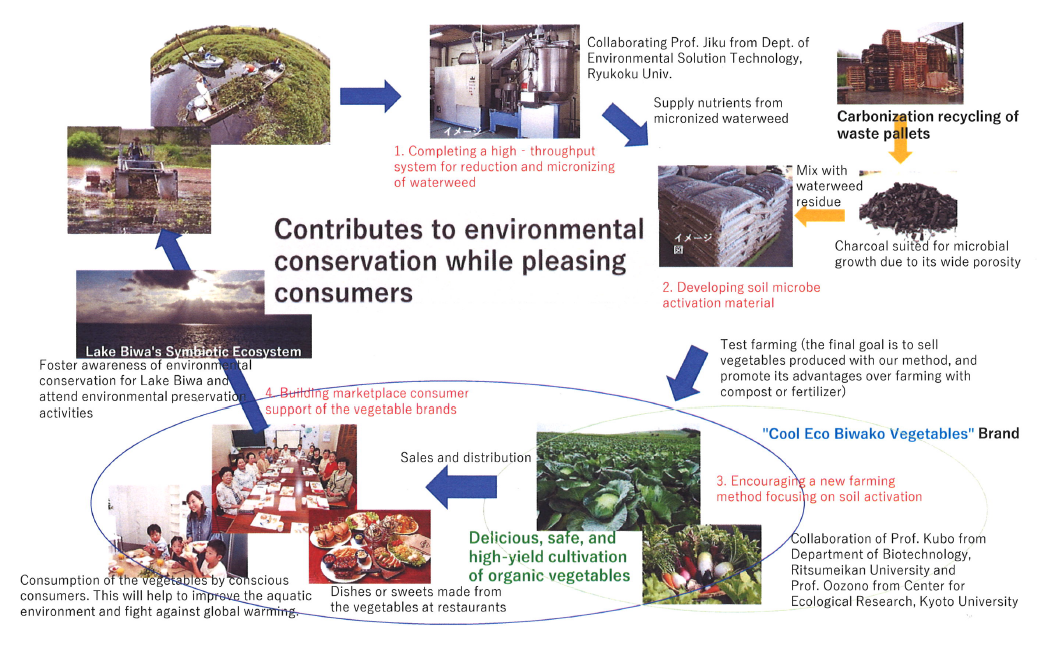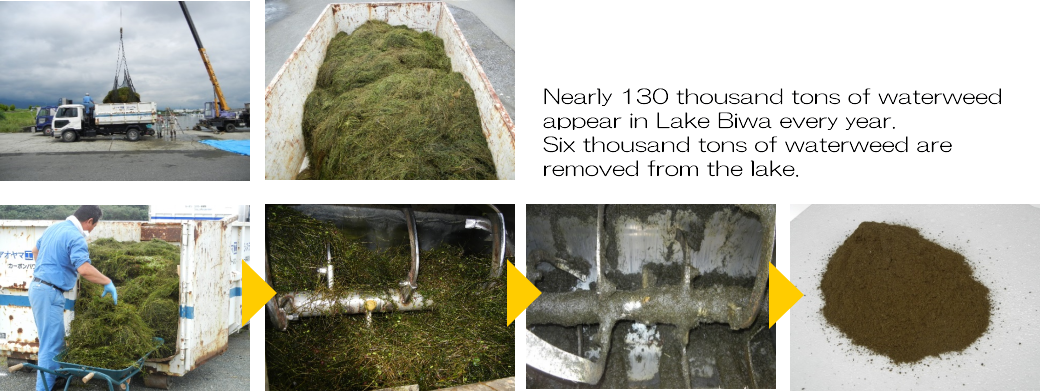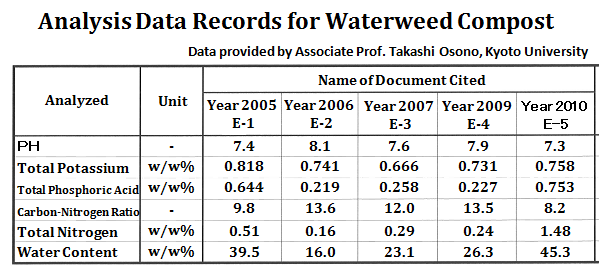Agriculture

Agricultural Use of Lake Biwa's Aquatic Plants
- Microbial agriculture ≠ Compost agriculture
-
Soil is composed of three elements: chemical, physical, and biological. The current agricultural method relies on chemical fertilizers, civil engineering for water drainage, and machine cultivation. Soil's chemical and physical elements were addressed through artificial improvements, while the biological element was basically neglected because its effect is ambiguous and hard to measure. Moreover, soil bacteria and other living creatures in the farm were thought to be nuisances that were better removed. As a result, soil's valuable properties disappeared through lack of nutrients and trace elements, leading to soil-borne infections and loss of its natural hydrating ability. This is the blind spot of modern agriculture.
This led to the rise of organic farming, but since organic farming has no clear definition, many understand the practice to be a simple addition of organic fertilizer to the soil. Fully-matured composting is the condition occurring when microbes consume all organic substance thus becoming inorganic. Using this compost does not increase microbes in the soil since there is little organic substance left to serve as food for the microbes.
The key for organic farming is the increase and activation of microbes. Our α-Gaia treatment system allows quick and direct decomposition of organic materials, which creates a perfect condition for microbes to eat decomposed material, allowing it to become nutrients for the soil.
In terms of soil fertilization, this process is far superior to normal composting. On top of the process our developed special charcoal, O+K Charcoal, is added to increase soil alkalinity for preventing growth of putrefactive bacterium. Also the charcoal's large pores attract various types of bacteria, such as actinomycetes and lactic acid bacteria to facilitate the fertilization. -
Waterweed contains very high water content levels (90 to 95%), therefore it would take 2 to 3 years to compost by natural drying.
However, it only requires 10 to 15 hours of processing with α-Gaia before it gets powderized. -
Although biomass level (total amount as organic substance) is almost the same, why does organic farming show a high soil carbon concentration level while standard farming does not? The answer may be the difference in speed of humic soil erosion. In organic farming, carbon exists as organic matter in the soil and then gradually and slowly decomposes until converting to carbon dioxide. However in standard farming, the use of soluble nitrogen fertilizer facilitates growth of putrefactive bacteria in the organic matter including carbon, so the carbon is quickly decomposed and released into the air as carbon dioxide.
The main goal of organic farming is to increase the soil's organic content in order to store more carbon. Successful organic farming which yields a high enough volume of good healthy vegetables to compete in the marketplace depends on how well we can store carbon and activate microbes in the soil. The principle of organic farming is to utilize natural resources for carbon recycling while reducing the amount of chemical fertilizers. This process will conserve energy resources, help increase agricultural profits, and minimize the use of hazardous fertilizers which may pose human and environmental health risks. -
・Energy-saving micro-powderization of waterweed
(converts it to organic compound state).
・Preventing waterweed-generated carbon from releasing into the atmosphere and
keeping it within the soil(increases carbonaceous organic soil matter).
・Carbonaceous organic matter activates and proliferates soil bacteria.
・Micro-powdered waterweed has high cation exchange capacity (CEC)
so it can contain high mineral content.
・Reducing fertilizers to establish environmentally-friendly farming.
・Improving the quality and yield of vegetables by activating and increasing
soil bacteria. -
1. On-site treatment (products from the process become feedstuff)
2. Compact methane power generation for waste untreatable by on-site system
(power generation ability)
A recycling system to make use of unwanted waterweed, add value to vegetable farming,
and enrich the global environment!

Establishes a new style of agriculture with new materials
Treating waterweed, water hyacinth, etc.

Analysis of Residual Material


Compare the results from 15 hours of α-Gaia treatment (top table) and 2 to 3 year span of natural compost (bottom table).
Organic farming isolates carbon from the atmosphere and create soil nutrients from it.
(Findings of Rodale Institute, USA)
A New Agricultural Method to Address Global Warming Using α-Gaia.
Distributed Treatment System of Raw Garbage and Organic Waste


